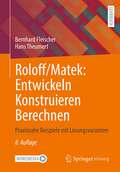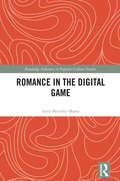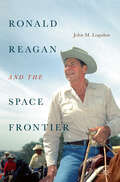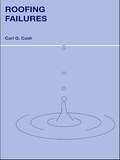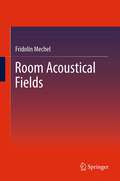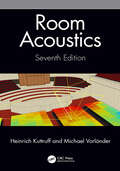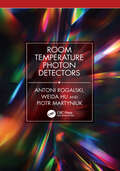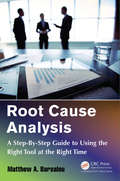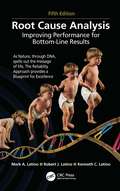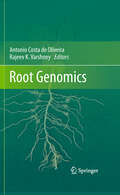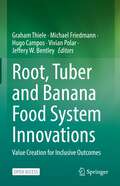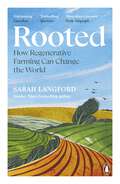- Table View
- List View
Roloff/Matek: Praxisnahe Beispiele mit Lösungsvarianten
by Bernhard Fleischer Hans TheumertDieses anschauliche Lehr- und Übungsbuch ergänzt das Lehr- und Lernsystem der Roloff/Matek Maschinenelemente und schließt die Lücke zwischen der Fokussierung auf einzelne Fachdisziplinen in der Konstruktion und einem Blick auf das Ganze. In Anlehnung an die VDI-Richtlinie 2221 wird der komplette Konstruktionsprozess an ausgewählten praxisnahen Beispielen abgebildet von den Kundenanforderungen bis zu fertigungsgerechten Werkstattzeichnungen. Dabei nehmen Umfang und Anspruch der Aufgaben über das Buch hinweg zu. Es werden Alternativlösungen vorgestellt und deren Vor- und Nachteile bewertet. Die Berechnung der Maschinenelemente erfolgt konsequent mittels Verweisen an der 26. Auflage der Roloff/Matek Maschinenelemente und die vorliegende Auflage erscheint erstmalig zusammen mit dem Lehr- und Lernsystem. Aufgrund der didaktischen Konzeption eignet sich dieses Buch auch sehr gut für das Selbststudium.
Romance in the Digital Game (Routledge Advances in Popular Culture Studies)
by Amy Brierley-BeareIn the last decade, the popularity of ‘romance’ in the AAA game has exploded. It has become an expectation for major releases and a regular object of fan obsession. High-profile games such as Baldur’s Gate III (2023), Cyberpunk 2077 (2020) and Starfield (2023) prominently feature in-game romance in their multimillion-dollar promotional campaigns. Moreover, rampant speculation by gaming journalists and fans about who is ‘romanceable’ will regularly accompany the announcement of a new title. However, representations of romance have long been under-examined and vaguely defined by scholars. This leaves important questions unanswered. How does the digital game mediate cultural attitudes towards love and sex? How can we classify representations of romance in the digital game? Does romance simply replicate existing hegemonies surrounding gender and sexuality, or does it offer a space for transgressive play?Book title positions optional romance in the AAA game as a central object of analysis. Based on the close analysis of some of the most commercially and culturally significant games of the last 30 years like Grand Theft Auto IV (2008), the Mass Effect series (2007-21) and the Elder Scrolls series (1994-2024), it is the first full-length monograph to effectively and comprehensively categorise how mainstream gaming asks its audience to engage with romance. It interrogates the idiosyncrasies of romance in the popular games to provide fresh insights into messaging surrounding normative social understandings of love, sex and intimacy.By theorising four representational categories of romance—Limerent, Physical, Domestic and Ludic—Automatic Love introduces a new theoretical framework for scholars to understand romance, gender and sexuality in gaming.
Romancing the Vine: Life, Love & Transformation in the Vineyards of Barolo
by Alan TardiIn Romancing the Vine, Alan Tardi, former owner of Follonico in New York, describes his life in the Piedmonte district of Italy focusing on the cultivation and harvest of the region's celebrated Barolo wine, and including rare local recipes.
Romantic Automata: Exhibitions, Figures, Organisms (Transits: Literature, Thought & Culture 1650-1850)
by Frederick Burwick Kathryn S. Freeman Erin M. Goss Ashley Shams Peter Erickson Wendy C. Nielsen Kate Singer Stefani Engelstein Lenora Hanson Christina Maria WeilerFor most of the eighteenth century, automata were deemed a celebration of human ingenuity, feats of science and reason. Among the Romantics, however, they prompted a contradictory apprehension about mechanization and contrivance: such science and engineering threatened the spiritual nature of life, the source of compassion in human society. A deep dread of puppets and the machinery that propels them consequently surfaced in late eighteenth and early nineteenth century literature. Romantic Automata is a collection of essays examining the rise of this cultural suspicion of mechanical imitations of life. Recent scholarship in post-humanism, post-colonialism, disability studies, post-modern feminism, eco-criticism, and radical Orientalism has significantly affected the critical discourse on this topic. In engaging with the work and thought of Coleridge, Poe, Hoffmann, Mary Shelley, and other Romantic luminaries, the contributors to this collection open new methodological approaches to understanding human interaction with technology that strives to simulate, supplement, or supplant organic life. Published by Bucknell University Press. Distributed worldwide by Rutgers University Press.
Rome
by Spiro Kostof Rabun Taylor Rinne Katherine WentworthSpanning the entire history of the city of Rome from Iron Age village to modern metropolis, this is the first book to take the long view of the Eternal City as an urban organism. Three thousand years old and counting, Rome has thrived almost from the start on self-reference, supplementing the everyday concerns of urban management and planning by projecting its own past onto the city of the moment. This is a study of the urban processes by which Rome's people and leaders, both as custodians of its illustrious past and as agents of its expansive power, have shaped and conditioned its urban fabric by manipulating geography and organizing space; planning infrastructure; designing and presiding over mythmaking, ritual, and stagecraft; controlling resident and transient populations; and exploiting Rome's standing as a seat of global power and a religious capital.
Ron's Robot (Fountas & Pinnell Classroom, Guided Reading)
by Katie Sharp Stephen GilpenNIMAC-sourced textbook. A Special Project. It is fun to make things. Ron and his grandpa have fun making a robot together. Read to find out how they do it.
Ronald E. Goldstein's Esthetics in Dentistry
by Ronald E. Goldstein Stephen J. Chu Ernesto A. Lee Christian F.J. StappertRonald E. Goldstein’s Esthetics in Dentistry, Third Edition provides a thoroughly updated and expanded revision to the definitive reference to all aspects of esthetic and cosmetic dentistry, from principles and treatments to specific challenges and complications. Provides a current, comprehensive examination of all aspects of esthetic and cosmetic dentistry Presents 23 new chapters from international experts in the field and complete updates to existing chapters Offers more than 3,700 high-quality photographs and illustrations Adds clinical case studies and treatment algorithms for increased clinical relevance Emphasizes clinical relevance, with all information thoroughly rooted in the scientific evidence
Ronald Reagan and the Space Frontier (Palgrave Studies in the History of Science and Technology)
by John M. LogsdonWhen Ronald Reagan was elected in 1980, limits on NASA funding and the lack of direction under the Nixon and Carter administrations had left the U.S. space program at a crossroads. In contrast to his predecessors, Reagan saw outer space as humanity’s final frontier and as an opportunity for global leadership. His optimism and belief in American exceptionalism guided a decade of U.S. activities in space, including bringing the space shuttle into operation, dealing with the 1986 Challenger accident and its aftermath, committing to a permanently crewed space station, encouraging private sector space efforts, and fostering international space partnerships with both U.S. allies and with the Soviet Union. Drawing from a trove of declassified primary source materials and oral history interviews, John M. Logsdon provides the first comprehensive account of Reagan’s civilian and commercial space policies during his eight years in the White House. Even as a fiscal conservative who was hesitant to increase NASA’s budget, Reagan’s enthusiasm for the space program made him perhaps the most pro-space president in American history.
Roofing Failures
by Carl G. CashThe book starts by setting out the duties of a building pathologist in the context of the modern roofing industry, defining failure and explaining its underlying causes. The main chapters then deal with the main specific types of failure: fire, shrinkage and roofing systems displacement, calendar shrinkage, foam insulation shrinkage and 'stretched' membranes, plasticizer migration, bitumen incompatibility, built-up roofing felt porosity, blistering, thermal insulation instability, foam insulation problems, torch applications, polymer dispersion, asphalt-glass fibre shingle splitting, lack of appropriate venting, problems with cool roofing and problems with organic fibre-portland cement shingles. The book concludes with an outline of the principal rules for long service life roofing.
Rooftop Urban Agriculture
by Francesco Orsini Marielle Dubbeling Henk De Zeeuw Giorgio GianquintoThis book guides architects, landscape designers, urban planners, agronomists and society on the implementation of sustainable rooftop farming projects. The interdisciplinary team of authors involved stresses the different approaches and the multi-faceted forms that rooftop farming may assume in any context. While rooftop farming experiences are sprouting all over the world the need for scientific evidence on the most suitable growing solutions, policies and potential benefits emerges. This volume brings together existing experiences as well as suggestions for planning future sustainable cities.
Room Acoustical Fields
by Fridolin MechelThis book presents the theory of room acoustical fields and revises the Mirror Source Methods for practical computational use, emphasizing the wave character of acoustical fields. The presented higher methods include the concepts of "Mirror Point Sources" and "Corner sources which allow for an excellent approximation of complex room geometries and even equipped rooms. In contrast to classical description, this book extends the theory of sound fields describing them by their complex sound pressure and the particle velocity. This approach enables accurate descriptions of interference and absorption phenomena.
Room Acoustics
by Heinrich KuttruffWell established as a classic reference and specialised textbook, since its first publication in 1973, Heinrich Kuttruff’s Room Acoustics combines detailed coverage with a state of art presentation of the theory and practice of sound behaviour in closed spaces. This sixth edition presents several additional new sections, for instance on the reflection of a spherical wave from a wall, on finite element methods for sound field calculation and on virtual reality, as well as giving an overhaul of the standard material. Particular emphasis is given to the properties and calculation of reverberation, the most obvious acoustical feature of a room. And further key topics include the various mechanisms of sound absorption and their practical application as well as scattering by wall irregularities including pseudo-stochastic structures. Extensive space is given to of psychoacoustic insights and the quality criteria derived from them, along with new procedures for the sensory assessment of concert hall acoustics. As in earlier editions, one full and updated chapter is devoted to the design and performance of electroacoustic systems which nowadays is not just a method for sound amplification but offers many possibilities for correcting acoustic deficiencies and modifying a hall’s natural acoustics.
Room Acoustics
by Heinrich Kuttruff Michael VorländerWell established as a classic reference and specialized textbook since its first publication in 1973, Room Acoustics combines detailed coverage with a state-of-the-art presentation of the theory and practice of sound behaviour in enclosed spaces.This seventh edition is developed to cover new measurement and simulation techniques, including sections on spatial and directional analysis and on recent psychophysical experimental approaches to determining auditory perception in concert halls. Other important topics include the various mechanisms of sound absorption and their practical application, as well as scattering through wall corrugations. The design and performance of sound reinforcement systems is also updated. As in previous editions, special emphasis is placed on the properties and calculation of reverberation.The book particularly suits graduate students in the field, acoustical engineers, and architects.
Room Temperature Photon Detectors
by Antoni Rogalski Weida Hu Piotr MartyniukRoom Temperature Photon Detectors provides an overview of the performance of emerging new generation of room temperature photodetectors generally called low-dimensional solid (LDS) photodetectors among which the most important are two-dimensional (2D) materials, perovskites, and quantum dots (QDs)/nanowires (NWs) operating in a wide spectral range from the ultraviolet (UV), visible (VIS), far infrared (FIR) to terahertz (THz). The LDS reported performance at room temperature is even better than that presented for standard commercial photodetectors.This book describes the peculiarities of the physical properties of LDS materials and their impact on the photodetectors’ performance. It also undertakes a comprehensive analysis of these performances when confronted with the standard photodetectors dominating the global market.Currently, intensive efforts are being made to reduce the cost of imaging systems and, in particular in the infrared (IR) range, to increase their operating temperature by reducing size, weight and power consumption (SWaP). This raises the question of whether the emergence of a new generation of LDS photodetectors will result in their rapid commercialization and serious competition for the standardized bulk photodetectors. This book attempts to answer those issues/questions.Features• Defines the importance of LDS photodetectors in the broad group of standard UV, VIS, IR, and THz photodetectors, and includes their advantages/disadvantages• Covers different types of photodetectors, including the relevant aspects of theory, types of materials, their physical properties, and detector fabrication• Provides invaluable resource for graduate students in physics and engineering, as well as a guide for those already working with sensors and systems, thermal imaging, remote sensing, optical telecommunications, and light detection.
Room-temperature Sodium-Sulfur Batteries: Anode, Cathode, and Electrolyte Design
by Vipin KumarThis book provides an effective review and critical analysis of the recently demonstrated room-temperature sodium-sulfur batteries. Divided into three sections, it highlights the status of the technologies and strategies developed for the sodium metal anode, insight into the development of sulfur cathode, and electrolyte engineering. It reviews past, present, and future perspectives for each cell component including characterization tools unveiling the fundamental understanding of the room-temperature sodium-sulfur batteries. FEATURES: Highlights scientific challenges in developing room-temperature sodium-sulfur batteries Covers pertinent anode, cathode, and electrolyte engineering Provides scientific and technical interpretation for each of the cell components Discusses how Na-S batteries relate to the more extensively researched Li-S batteries Explores importance of the SEI and CEI in developing stable sodium-sulfur batteries This book is aimed at graduate students and researchers in energy science, materials science, and electrochemistry.
Root Cause Analysis (RCA) for the Improvement of Healthcare Systems and Patient Safety
by David Allison, CPPS Harold Peters, P.Eng.The book follows a proven training outline, including real-life examples and exercises, to teach healthcare professionals and students how to lead effective and successful Root Cause Analysis (RCA) to eliminate patient harm. This book discusses the need for RCA in the healthcare sector, providing practical advice for its facilitation. It addresses when to use RCA, how to create effective RCA action plans, and how to prevent common RCA failures. An RCA training curriculum is also included. This book is intended for those leading RCAs of patient harm events, leaders, students, and patient safety advocates who are interested in gaining more knowledge about RCA in healthcare.
Root Cause Analysis: A Step-By-Step Guide to Using the Right Tool at the Right Time
by Matthew A. BarsalouAlthough there are many books on root cause analysis (RCA), most concentrate on team actions such as brainstorming and using quality tools to discuss the failure under investigation. These may be necessary steps during RCA, but authors often fail to mention the most important member of an RCA team the failed part.Root Cause Analysis: A Step-By-Step
Root Cause Analysis: Improving Performance for Bottom-Line Results, Fifth Edition
by Mark A. Latino Robert J. Latino Kenneth C. LatinoThis book comprehensively outlines what a holistic and effective Root Cause Analysis (RCA) system looks like. From the designing of the support infrastructure to the measuring of effectiveness on the bottom-line, this book provides the blueprint for making it happen. While traditionally RCA is viewed as a reactive tool, the authors will show how it can be applied proactively to prevent failures from occurring in the first place. RCA is a key element of any successful Reliability Engineering initiative. Such initiatives are comprised of equipment, process and human reliability foundations. Human reliability is critical to the success of a true RCA approach. This book explores the anatomy of a failure (undesirable outcome) as well as a potential failure (high risks). Virtually all failures are triggered by errors of omission or commission by human beings. The methodologies described in this book are applicable to any industry because the focus is on the human being's ability to think through why things go wrong, not on the industry or the nature of the failure. This book correlates reliability to safety as well as human performance improvement efforts. The author has provided a healthy balance between theory and practical application, wrapping up with case studies demonstrating bottom-line results. Features Outlines in detail every aspect of an effective RCA ‘system’ Displays appreciation for the role of understanding the physics of a failure as well as the human and system’s contribution Demonstrates the role of RCA in a comprehensive Asset Performance Management (APM) system Explores the correlation between Reliability Engineering and safety Integrates the concepts of Human Performance Improvement, Learning Teams, and Human Error Reduction approaches into RCA
Root Cause Failure Analysis: A Guide to Improve Plant Reliability
by Trinath SahooRoot Cause Failure Analysis Provides the knowledge and failure analysis skills necessary for preventing and investigating process equipment failuresProcess equipment and piping systems are essential for plant availability and performance. Regularly exposed to hazardous service conditions and damage mechanisms, these critical plant assets can result in major failures if not effectively monitored and assessed—potentially causing serious injuries and significant business losses. When used proactively, Root Cause Failure Analysis (RCFA) helps reliability engineers inspect the process equipment and piping system before any abnormal conditions occur. RCFA is equally important after a failure happens: it determines the impact of a failure, helps control the resultant damage, and identifies the steps for preventing future problems.Root Cause Failure Analysis: A Guide to Improve Plant Reliability offers readers clear understanding of degradation mechanisms of process equipment and the concepts needed to perform industrial RCFA investigations. This comprehensive resource describes the methodology of RCFA and provides multiple techniques and industry practices for identifying, predicting, and evaluating equipment failures. Divided into two parts, the text first introduces Root Cause Analysis, explains the failure analysis process, and discusses the management of both human and latent error. The second part focuses on failure analysis of various components such as bolted joints, mechanical seals, steam traps, gearboxes, bearings, couplings, pumps, and compressors. This authoritative volume:Illustrates how failures are associated with part integrity, a complete system, or the execution of an engineering processDescribes how proper design, operation, and maintenance of the equipment help to enhance their reliabilityCovers analysis techniques and industry practices including 5-Why RCFA, fault tree analysis, Pareto charts, and Ishikawa diagramsFeatures a detailed case study of process plant machinery and a chapter on proactive measures for avoiding failuresBridging the gap between engineering education and practical application, Root Cause Failure Analysis: A Guide to Improve Plant Reliability is an important reference and guide for industrial professionals, including process plant engineers, planning managers, operation and maintenance engineers, process designers, chemical engineers, and instrument engineers. It is also a valuable text for researchers, instructors, and students in relevant areas of engineering and science.
Root Cellaring: Natural Cold Storage of Fruits and Vegetables
by Mike Bubel Nancy BubelAnyone can learn to store fruits and vegetables safely and naturally with a cool, dark space (even a closet!) and the step-by-step advice in this book.
Root Genomics
by Antonio Costa de Oliveira Rajeev VarshneyWith the predicted increase of the human population and the subsequent need for larger food supplies, root health in crop plants could play a major role in providing sustainable highly productive crops that can cope with global climate changes. While the essentiality of roots and their relation to plant performance is broadly recognized, less is known about their role in plant growth and development. "Root Genomics" examines how various new genomic technologies are rapidly being applied to the study of roots, including high-throughput sequencing and genotyping, TILLING, transcription factor analysis, comparative genomics, gene discovery and transcriptional profiling, post-transcriptional events regulating microRNAs, proteome profiling and the use of molecular markers such as SSRs, DArTs, and SNPs for QTL analyses and the identification of superior genes/alleles. The book also covers topics such as the molecular breeding of crops in problematic soils and the responses of roots to a variety of stresses.
Root, Tuber and Banana Food System Innovations: Value Creation for Inclusive Outcomes
by Graham Thiele Hugo Campos Michael Friedmann Vivian Polar Jeffery W. BentleyThis open access book describes recent innovations in food systems based on root, tuber and banana crops in developing countries. These innovations respond to many of the challenges facing these vital crops, linked to their vegetative seed and bulky and perishable produce. The innovations create value, food, jobs and new sources of income while improving the wellbeing and quality of life of their users. Women are often key players in the production, processing and marketing of roots, tubers and bananas, so successful innovation needs to consider gender. These crops and their value chains have long been neglected by research and development, hence this book contributes to filling in the gap. The book features many outcomes of the CGIAR Research Program in Roots, Tubers and Banana (RTB), which operated from 2012-21, encompassing many tropical countries, academic and industry partners, multiple crops, and major initiatives. It describes the successful innovation model developed by RTB that brings together diverse partners and organizations, to create value for the end users and to generate positive economic and social outcomes. RTB has accelerated the scaling of innovations to reach many end users cost effectively. Though most of the book’s examples and insights are from Africa, they can be applied worldwide. The book will be useful for decision makers designing policies to scale up agricultural solutions, for researchers and extension specialists seeking practical ideas, and for scholars of innovation.
Rooted: Stories of Life, Land and a Farming Revolution
by Sarah LangfordSHORTLISTED FOR THE WAINWRIGHT PRIZE FOR NATURE WRITING'An honest look at the farming life today. Raw, earthy and inspiring' - Cal Flyn, author of Islands of Abandonment'A beautifully written, incredibly timely book' - Clover Stroud, author of My Wild and Sleepless NightsWhen barrister and author Sarah Langford left her city life behind she found herself unexpectedly back in the world of farming. It was not how she remembered. Instead, she saw farmers dealing with very different problems to those faced by her grandfather, considered a hero for having fed a starving nation after war. Now farmers faced accusations of ecological mismanagement by a hostile urban media whilst battling extreme weather and political upheaval. Yet as Sarah learned how to farm and grew closer to the land, she discovered a new generation on a path of regenerative change.In Rooted, Sarah weaves her own story around those who taught her what it means to be a farmer. She shines a light on the human side of modern farming, and shows how land connects us all, not only in terms of global sustainability but in our relationships with our physical and mental health, our communities and our planet.'Moving, startling, uplifting, galvanising and unsettling, this plainly beautiful book is one of those rare few that changes how you see the world around you' - Ella Risbridger, author of The Year of Miracles'Heartbreaking and hopeful, this story of a farming revival has never been more important' - Esther Freud
Roots, Tubers, and Bulb Crop Wastes: Management by Biorefinery Approaches
by Ramesh C. RayThis edited book brings forth comprehensive information on the bioprocessing and biovalorization of root (i.e., cassava, sweet potato, yams, and aroids), tuber (i.e., potato, carrot, turnip, artichoke and beet root), and bulb (i.e., onion and garlic) crop wastes into various products and platform chemicals in a biorefinery approach. The non-edible portion of roots, tubers, and bulb crops, after processing (waste), such as peels, skins, pulps, rejects, and unmarketable tubers, account for about 20–40% of the total weight of the fresh produce. Tropical tuber crops such as cassava, yams, aroids, and sweet potato generate bagasse, the byproduct of the starch processing industry, which contains about 30–50% starch and fibrous materials on a dry weight basis. Similarly, the husk is the leading waste from onion and garlic processing. The amount of waste and byproducts of potato industry is estimated to be around 12–20% of their total production. These wastes pose increasing disposal and potentially severe pollution problems and represent a loss of valuable biomass and nutrients. Roots, tubers, and bulb wastes usually have a composition of sugar, starch, proteins, phenolic phytochemicals, fibers, and minerals. Therefore, they should not be considered as “wastes” but raw materials for other industrial processes in the biorefinery approach. These wastes provide conditions amenable for the growth of microorganisms and opens up great opportunities for their reuse in fermentation processes to develop value-added bioproducts such as enzymes, single-cell proteins, bio-absorbents, phenolic bioactive compounds, aroma and flavor compounds, organic acids, and biofuels. This book fills the gap in literature about the processes and by-products. The book is composed of 16- chapters deep diving into valorization and bioprocessing of a range of tuber crop waste. The book explores these processes in 11 different crops and highlights the life cycle assessment as well as highlightsthe opportunities about commercialization of technologies used in bioprocessing and bio-valorization of root crop waste. The processes explained in the book are rooted in the principles of circular economy. This book is of interest to teachers, researchers, environmentalists, bio-based industrialist, and policymakers.
Rope Rescue: Principles and Practice, 5e
by Loui McCurley Tom VinesRope Rescue Techniques: Principles & Practice, Fifth Edition provides comprehensive coverage of all aspects of rope rescue, including planning, PPE and equipment, medical considerations, evacuations, and special rescue operations. Based on the 2021 Edition of NFPA 1006 (Chapter 5), Standard for Technical Rescuer Professional Qualifications, the fifth edition has been significantly revised to reorganize content by Awareness, Operations, and Technician levels.Prepare to succeed in the classroom, on the training ground, and in the field.For fire and rescue professionals that want to bridge the gap between training and the field, the fifth edition reinforces proper skills performance by providing clear, visual instructions for awareness, operations, and technician level skills.A wealth of visual skill drills are included throughout to illustrate step-by-step instructions with photos for completing specific skills.New Size-up chapter helps define the role of the awareness-level rescuer in scene size-up, including how to interview witnesses to determine victim location and the scope of the incidentExpanded coverage of preplanning and hazard identification, risk assessment, and maintaining situational awarenessNew content on SMART method to developing an Incident Action Plan, hazard-specific PPE, rope systems equipment, rigging principles, and active fall protection. . © 2023 | 448 pages
